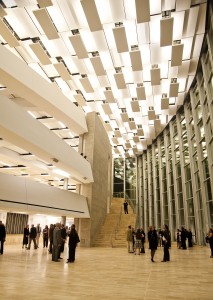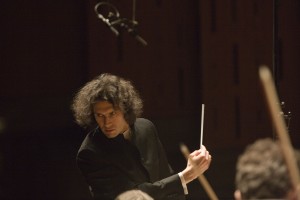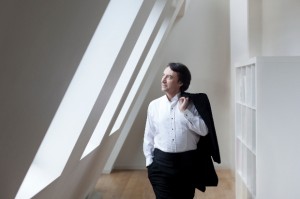NOTHING FOGGY ABOUT THIS LONDON OUTFIT
Yet again, the Valley Performing Arts Center (VPAC) is proven to be one of the best venues for music concerts in this or any other city. Not only is the gorgeous hall blessed with terrific sight lines and extraordinary acoustics, but the ticket prices are basically half of what you would pay for classical music in many other arenas.
The London Philharmonic Orchestra (LPO) is on tour, and validated last night why it is so popular. The plentitude of players on stage at VPAC was mind boggling, and the effort it must take to pull off, let alone pay for, such a tour is almost inconceivable. Since 1932, LPO has seen its share of ups and downs, including the fact that there are 4 other permanent orchestras in London competing for attention. But leadership from conductors such as Georg Solti and Kurt Masur thrust LPO into the limelight, and the estimable company is, since 1992, the Resident Orchestra at the Royal Festival Hall. Here in the states, LPO is best-known for its work on film soundtracks, including Lawrence of Arabia, Star Wars, and The Lord of the Rings trilogy.
Lucky for us that this premier orchestra arrived with Moscow-born Vladimir Jurowski, the Principal Conductor since 2007. Hardly effusive physically, Jurowski appeared more like an intense magician who spellbinds with brilliant sleight-of-hand and an intense gaze. Yet he surprisingly brought the players alive as if he were running a marathon. His unruly, long brown mane’”a prototype for mad genius conductors’”often hid his facial characteristics, but when seen, his piercing eyes resembled an egret just before it pounces on a meal. The orchestra had snap and personality, and there was no shortage of energy reverberating through the near-capacity, 1700-seat house.
The proof of the orchestra’s tenacity was in the programming, which was hardly adventurous, especially Dvořák’s The Noon Witch (1896), the least popular of his four short tone poems, and Tchaikovsky’s oft-played Symphony No. 6, Pathétique. However, the excitement generated from Jurowski’s fresh interpretations rejuvenated the life of these works as if they had just returned from an invigorating spa.
Knowing the story of The Noon Witch helps immensely: To frighten her child into good behavior, a mother threatens to summon a witch. A hag actually appears. When the father returns home, he finds a dead wife and child. This folk story seems to have a moral for both parent (as per Sondheim, “Careful the things you say”) and child (heed your parents). The dark, ominous tones were actually spooky in this rendering, which made the upbeat return of the unknowing father all the more heartbreaking.
 You could feel the energy feeding on itself during Pathétique. The opening, normally a stodgy affair, came alive with tonal qualities we don’t normally hear, and the interpretation, which allowed for character within the timbre, grew in stature. The oddly limping waltz movement became bittersweet and the third movement blazed tremendously’”the brass was positively let off the leash (the house roared for tubist Lee Tsarmaklis afterward). The final Adagio lamentoso had both pathos and dignity’”full of heart but not worn on the sleeve.
You could feel the energy feeding on itself during Pathétique. The opening, normally a stodgy affair, came alive with tonal qualities we don’t normally hear, and the interpretation, which allowed for character within the timbre, grew in stature. The oddly limping waltz movement became bittersweet and the third movement blazed tremendously’”the brass was positively let off the leash (the house roared for tubist Lee Tsarmaklis afterward). The final Adagio lamentoso had both pathos and dignity’”full of heart but not worn on the sleeve.
French pianist Jean-Efflam Bavouzet was the soloist in a white-knuckle, pulsating performance of Prokofiev’s Piano Concerto No 3, a notoriously demanding piano score with many rhythmic challenges. His playing was full of attack where required, but also sincere and emotional in the concerto’s more tranquil passages. He was warm, witty, and fresh, and his swells of supremacy in the first movement’s reprise and in the finale’s coda were astonishing. The finale’s glides from one pitch to another were virtuosic; even with centrifugal-force speed the attention to detail was crisp. There wasn’t a moment when you couldn’t hear the work’s dazzling personality streaming through his playing.
 The interchange with the orchestra was a stunning achievement, given the difficult task of balancing Prokofiev’s impressionism with the work’s technical challenges. The appearance of effortlessness on Bavouzet’s part was amazing, and Jurowski did a praiseworthy job of shaping a performance of great musicality. Occasionally, the pianist was drowned out by the orchestra, but it is uncertain whether he was too delicate or if it was due to his placement just in front of the orchestra shell.
The interchange with the orchestra was a stunning achievement, given the difficult task of balancing Prokofiev’s impressionism with the work’s technical challenges. The appearance of effortlessness on Bavouzet’s part was amazing, and Jurowski did a praiseworthy job of shaping a performance of great musicality. Occasionally, the pianist was drowned out by the orchestra, but it is uncertain whether he was too delicate or if it was due to his placement just in front of the orchestra shell.
The only drawback of the stellar acoustics at VPAC is that one noisy audience member can be heard vividly: One patron’s listening device offered horrendous feedback because the hearing aid was not removed. Hopefully, an announcement will be made before future concerts to remind listeners of their obligations. The same program will be offered by LPO tonight at Segerstrom Concert Hall.
photos courtesy of VPAC and LPO (Richard Cannon)
center triptych photo of Vladimir Jurowski by Klaus Rudolph
London Philharmonic Orchestra
Vladimir Jurowski, conductor
Jean-Efflam Bavouzet, piano
Valley Performing Arts Center in Northridge
played Friday, October 10, 2014 at 8:00 pm
for future events, call (818) 677-3000
or visit www.ValleyPerformingArtsCenter.org
Renée and Henry Segerstrom Concert Hall in Costa Mesa
presented by the Philharmonic Society
Saturday, October 11, 2014, at 8:00 pm
pre-concert lecture by Alan Chapman at 7:00
for tickets, call (949) 553-2422 or visit www.philharmonicsociety.org





